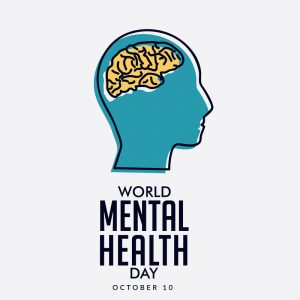Today is #WorldMentalHealthDay; a day for global mental health education, awareness and advocacy!
This years’s theme Dignity in Mental Health-Psychological & Mental Health First Aid for All will enable us to contribute to the goal of taking mental health out of the shadows so that people in general feel more confident in tackling the stigma, isolation and discrimination that continues to plague people with mental health conditions, their families and careers.

As a mental health advocate, and as someone who has experienced episodes of anxiety, I know how difficult it may be to raise awareness around an issue that is often portrayed as a sign of weakness. I personally do not consider myself weak, despite what society may say, and this is why I think it is so important that we break the stigma and the silence around mental illness . We’ve all experienced our share of highs and lows, but we don’t talk enough about our lows that many of us imagine that we are alone in feeling this way. Social media makes it very easy to imagine that everyone is living life where the grass is greener, but who are we kidding? It’s very rare that you see someone post a picture of themselves sad, alone or struggling. But just because you don’t see it, doesn’t mean that others aren’t feeling the stress, anxiety, or sadness that you may be feeling too. I do not live a perfect life. I have been sad; I have been stressed; I have felt extremely anxious about things that I look back now and say, really? But it’s something I can’t help. What I can do, however, is start speaking up and showing people that even those you may see as leaders or as successful go through tough times. You are not alone. – Amanda Bernardo
If we begin to use our little voice to speak up on causes like mental health, maybe just maybe, we’d be able to support more people who are struggling in silence.
So, to help create awareness, please read these facts about mental health in Canada. Share them, your story, and help break the stigma.
Who is affected?
- Mental illness indirectly affects all Canadians at some time through a family member, friend or colleague.
- 20% of Canadians will personally experience a mental illness in their lifetime.
- Mental illness affects people of all ages, educational and income levels, and cultures.
- Approximately 8% of adults will experience major depression at some time in their lives.
- About 1% of Canadians will experience bipolar disorder (or “manic depression”).
How common is it?
- Schizophrenia affects 1% of the Canadian population.
- Anxiety disorders affect 5% of the household population, causing mild to severe impairment.
- Suicide accounts for 24% of all deaths among 15-24 year olds and 16% among 25-44 year olds.
- Suicide is one of the leading causes of death in both men and women from adolescence to middle age.
- The mortality rate due to suicide among men is four times the rate among women.
What causes it?
- A complex interplay of genetic, biological, personality and environmental factors causes mental illnesses.
- Almost one half (49%) of those who feel they have suffered from depression or anxiety have never gone to see a doctor about this problem.
- Stigma or discrimination attached to mental illnesses presents a serious barrier, not only to diagnosis and treatment but also to acceptance in the community.
- Mental illnesses can be treated effectively.
What is the economic cost?
- The economic cost of mental illnesses in Canada for the health care system was estimated to be at least $7.9 billion in 1998 – $4.7 billion in care, and $3.2 billion in disability and early death.
- An additional $6.3 billion was spent on uninsured mental health services and time off work for depression and distress that was not treated by the health care system.
- In 1999, 3.8% of all admissions in general hospitals (1.5 million hospital days) were due to anxiety disorders, bipolar disorders, schizophrenia, major depression, personality disorders, eating disorders and suicidal behavior.Sources: The Report on Mental Illness in Canada, October 2002. EBIC 1998 (Health Canada 2002), Stephens et al., 2001
How does it impact youth?
- It is estimated that 10-20% of Canadian youth are affected by a mental illness or disorder – the single most disabling group of disorders worldwide.
- Today, approximately 5% of male youth and 12% of female youth, age 12 to 19, have experienced a major depressive episode.
- The total number of 12-19 year olds in Canada at risk for developing depression is a staggering 3.2 million.
- Once depression is recognized, help can make a difference for 80% of people who are affected, allowing them to get back to their regular activities.
- Mental illness is increasingly threatening the lives of our children; with Canada’s youth suicide rate the third highest in the industrialized world.
- Suicide is among the leading causes of death in 15-24 year old Canadians, second only to accidents; 4,000 people die prematurely each year by suicide.
- Schizophrenia is youth’s greatest disabler as it strikes most often in the 16 to 30 year age group, affecting an estimated one person in 100.
- Surpassed only by injuries, mental disorders in youth are ranked as the second highest hospital care expenditure in Canada.
- In Canada, only 1 out of 5 children who need mental health services receives them.
